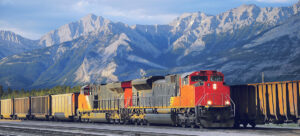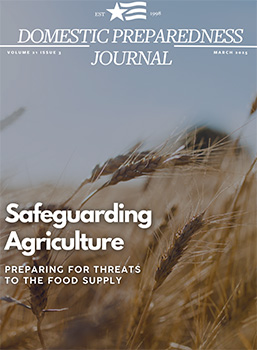
Agriculture Security: Systems-Based Preparedness
Joshua Dise and Adrian Self
March 26, 2025
As economies and populations grow, the food and agricultural security is of increasing concern. This demands proactive investment in risk management and security measures to ensure the sustainability of the global food supply.

Editor’s Note – Protecting Food and Agriculture: Bigger Than Rising Egg Prices
Catherine L. Feinman
March 26, 2025
The authors in the March 2024 edition of the Domestic Preparedness Journal share their expert insights on topics that may be overlooked by nonrural communities and why common agricultural and critical infrastructure operations should be on the minds of any emergency preparedness professional.

Farm to Power: New Hazards in Rural Communities
Russ Kane
March 26, 2025
In the interest of reducing methane pollution and establishing a revenue stream for a renewable resource, dairy and livestock operators are creating mechanisms to produce compressed natural gas. This new technology reduces greenhouse gases but also introduces new hazards to rural communities.

Podcast – Advisory Board Spotlight: Interview With Anthony Mangeri
Anthony S. Mangeri
March 19, 2025
Anthony Mangeri is an educator and seasoned leader in emergency management. He is the chief operating officer of the Mangeri Group and the immediate past president of the International Association of Emergency Managers (IAEM) Region 2. Learn about Anthony’s passion for his field and for the Domestic Preparedness Journal.

Agricultural Supply Chain Vulnerability: A Freight Rail Disruption Case Study
Michael Sharon and Randy Treadwell
March 19, 2025
The agricultural supply chain’s global interdependency introduces considerable vulnerability. The failure or weakening of even one of the supply chain links has cascading effects. Awareness of potential catastrophe across sectors is crucial to emergency preparedness.

Agroterrorism: A Persistent but Overlooked Threat
Dan Scherr and Tanya M. Scherr
March 19, 2025
Agroterrorism is not new. Considered a subset of bioterrorism, it has become an increasing concern to the U.S. With so much of the agriculture sector in private hands, preparedness leaders must take extra steps to engage stakeholders and incorporate them into planning efforts.

The Societal and Economic Dangers of Agroterrorism
Michael (Mike) Nicholls
March 12, 2025
While Ireland’s potato blight was destructive to the Irish population, modern agroterror attacks could be designed to hurt a nation’s economy rather than to kill its people. However, positively identifying agroterrorists would be a formidable task.

Cost Analysis: Protecting the Grid and Electronics from an EMP
The Foundation for Infrastructure Resilience
March 12, 2025
Because modern societies are increasingly reliant on electronics, they are more vulnerable to the effects of an electromagnetic pulse event. As nations move to electrify their critical infrastructure and essential services, the cascading effects of a power grid disruption increase their vulnerability.

Beyond the Showcase: Strengthening Biosecurity at Livestock Exhibitions
Joshua Dise
March 5, 2025
Hazards and risks associated with state and local fairs mirror those of other high-attendance events—medical emergencies, mass casualty incidents, and other public safety risks. However, within the food and agriculture sector lies an additional risk: the spread of animal diseases, which can have catastrophic consequences.

The Human Factor in Cybersecurity Events: Critical Education Components
Dan Scherr and Tanya M. Scherr
March 5, 2025
When considering cyberattack risk, understanding the primacy of the human factor is central in developing plans for continuity of operations and incident response. With the increasing cost of data breaches, it is increasingly important to educate users on best practices and to employ robust security programs.


